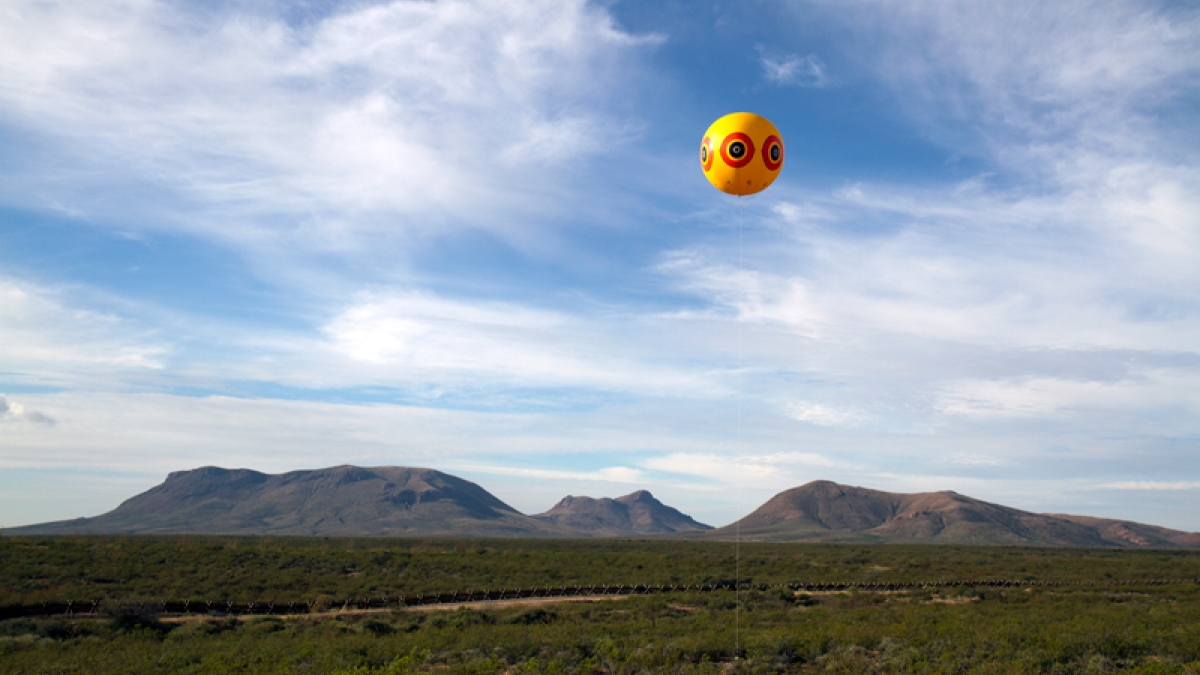Artist collective Postcommodity presents ambitious installation on U.S.-Mexico Border this October

Image courtesy of Postcommodity.
Photo courtesy of Herberger Institute for Design and the Arts
This October, three artists — members of an indigenous artist collective called Postcommodity — will install the largest-ever bi-national land art piece on the U.S.-Mexico border.
It’s the “continuation of an exploration of contested spaces,” says the group. “Repellent Fence” is the product of over three years of work by Postcommodity members Raven Chacon, Cristóbal Martínez and Kade L. Twist, who have been in residence at the ASU Art Museum’s International Artist Residency Program several times as they worked to realize their vision for the installation.
“The residency program has been amazing — it’s comfortable, well-appointed, right in the middle of Phoenix, and surrounded by a generative and talented art community. It’s an ideal home base to realize a project,” says Twist. “All of the resources that the museum and its staff leverage on behalf of the artists have brought so much to the table. I can’t even begin to explain how important this residency has been in terms of realizing the ‘Repellent Fence.’”
The “fence” itself, which will be installed through community action from Oct. 9–12, 2015 near Douglas, Ariz. and Agua Prieta, Mexico, is comprised of over two dozen massive balloons — each 10 feet in diameter — that will float 50 feet above the desert landscape. Together, they will create a temporary two-mile-long sculpture that intersects the U.S./Mexico border.
The balloons are scaled-up replicas of “scare eye” balloons, a consumer product designed to repel birds. Postcommodity notes that the “scare eye,” which looks similar to a yellow and red bull’s-eye target, actually “utilizes iconography and traditional medicinal colors used for thousands of years by indigenous peoples from South America to Canada.” Through appropriating that iconography in their project, the collective hopes to open a dialogue about indigenous cultural relationships to land, and to “demonstrate the interconnectedness of the Western Hemisphere by recognizing indigenous peoples and long-view histories that encapsulate migration, trade, relationships, communication and cultural exchange.”
Twist and Martinez are both ASU alums — Twist received a Master of Fine Arts from the ASU School of Art, and Martinez received a doctorate in rhetoric, composition and linguistics from the Department of English in the College of Liberal Arts and Sciences in 2015, after completing a master’s in media arts and science and bachelor’s degrees in studio art and painting, in the Herberger Institute’s School of Arts, Media + Engineering and School of Art, respectively. They’re also not strangers to international art fame. In 2012, they, along with the rest of Postcommodity, exhibited at the 18th Sydney Biennale. The project they presented, “Do You Remember When,” was commissioned by the ASU Art Museum and originally unveiled at the museum’s Ceramics Research Center in 2009.
To make “Repellent Fence” a reality, Postcommodity conducted dozens of meetings with individuals, communities and local organizations to acquire permission to stage the installation and to ensure safe public access for audiences viewing the project, which will be installed on public and private land in Mexico and Arizona. They chose to work outside the framework of arts institutions and galleries to emphasize the power of international collaboration and the desire of border cities to “redefine dialogue.”
The monumental installation is just one part of a larger public engagement campaign that will include public programming, performances and the first-ever cross-border art walk in Douglas and Agua Prieta. Over the course of the weekend, the Arizona Commission on the Arts will present a series of artist workshops and artist-led community conversations featuring several artists local to Douglas, including ASU School of Art alumna M. Jenea Sanchez, as part of their new AZ ArtWorker Initiative. Visual and performance artist Ana Teresa Fernández will also visit Douglas as part of her residency with ASU’s Performance in the Borderlands, an initiative of the ASU School of Film, Dance and Theatre.
With just a few weeks remaining before “Repellent Fence” is installed at the border, the group is excited. “The installation itself is significant, because it is a large-scale manifestation of intense bi-national dialogue, collaboration and diplomacy,” says Martinez. “This represents the self-determination of Douglas and Agua Prieta to collaborate with one another and unify their communities despite the border wall.”
“This act of re-inhabiting historically shared terrain and marking it with contemporary versions of ancient icons reveals the U.S./Mexico border to be what it is: the arbitrary and artificial overlay of power derived through coercion,” says Gordon Knox, ASU Art Museum director. “I am delighted that the museum’s residency program can serve as a springboard for artists of Postcommodity’s caliber and enable cross-disciplinary projects like ‘Repellent Fence.’”
“Repellent Fence” is presented in collaboration with the ASU Art Museum and is supported by Creative Capital, Native Arts and Cultures Foundation, Joan Mitchell Foundation and Art Matters.
The public is invited to attend “Repellent Fence” and the surrounding programming, Oct. 9–12, 2015 in Douglas and Agua Prieta. A full schedule of events and more details on the project are available at
repellentfence.com.
Media Contact:
Juno Schaser
PR Specialist
480.965.0014
juno.schaser@asu.edu

